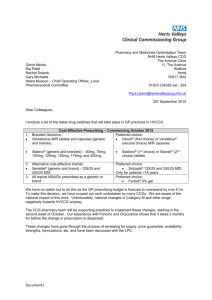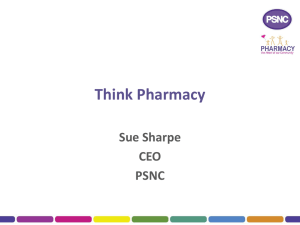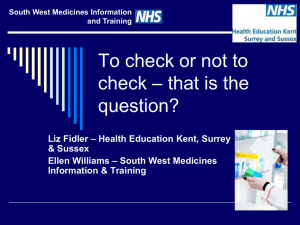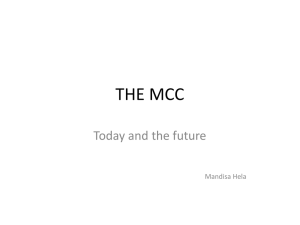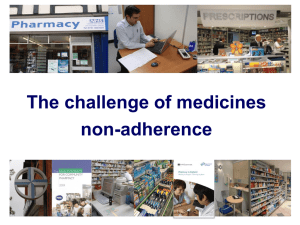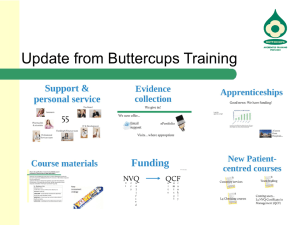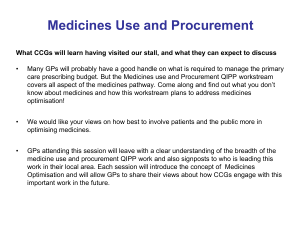Mike Scott`s Presentation
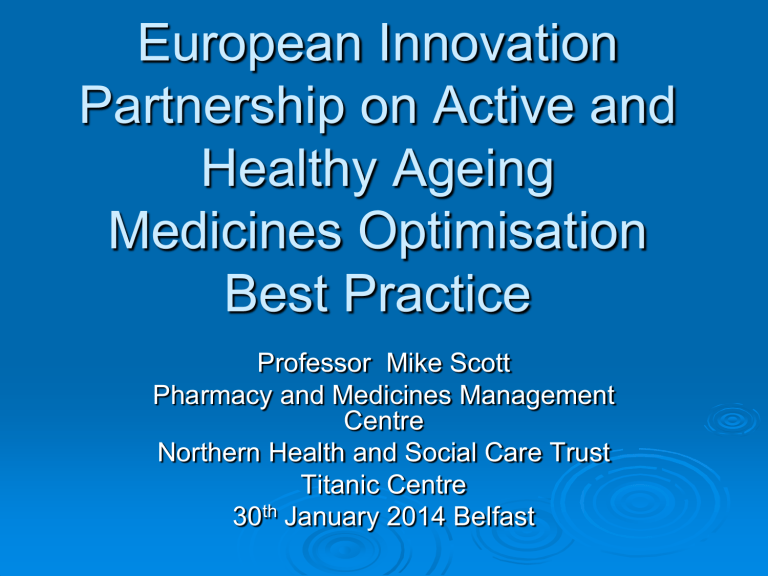
European Innovation
Partnership on Active and
Healthy Ageing
Medicines Optimisation
Best Practice
Professor Mike Scott
Pharmacy and Medicines Management
Centre
Northern Health and Social Care Trust
Titanic Centre
30 th January 2014 Belfast
Time line
2000-2004 Integrated Medicines Management
(IMM)-patients over 65 years of age
2005-present Pharmaceutical Clinical
Effectiveness
2006 - Safer Patient Initiative (International
Healthcare Improvement (IHI) )
2010- present Innovation Programme
How was it initiated
Business case was produced indicating the work that was proposed
Resources required to undertake
Process measures
Clear outcome measures
Research base methodology
How Was Political Support
Obtained
Northern Ireland Executive Innovation
Fund proposal (1999)
Citizen Benefits for older people predicated on previous local evidence
How was financial support secured
Executive programme funds Euro 720k first three years for the pilot
Based on positive outcomes further investment over the next five years Euro 4.8million
Return on Investment:
For very 3 euro invested per head of population
15 Euro returned
Innovation programme 840k Euro
Stakeholder Buy -in
All relevant stakeholders were involved at the outset
Integration of the key healthcare team members
In the Pharmaceutical Clinical Effectiveness
Programme there is a multidisciplinary collaborative approach to reach consensus on clinical products based on safety and quality
Implementation of the technical solution
Comprehensive education and training
Integration with medical and nursing colleagues in both primary and secondary care
Standard operating procedure development
Documentation development
Skill mix and role clarity
Software development for both operational use and process and outcome capture
Robust research based methodology-University linkage
How change management was implemented
Extensive pre implementation discussion with all key stakeholder groups
Workshops and presentations
Roadshows
Oversight group
Operational group
AIM
To optimise the benefits that patients gain from prescribed treatments through innovative technology-supported solutions delivered through intra professional and intra sectoral systems change
Medicine Optimisation Objectives
Right Drug
Selection
Matrix methodology
STEPSelect (Safe Therapeutic Economic
Pharmaceutical Selection) optimise acquisition cost
Formulary management
Guideline development
Medicine Optimisation Objectives
Right Patient
Re-engineered clinical pharmacy services in the hospital setting (older patients)(EPICS-
Electronic Pharmacist Clinical Intervention
System)
Focus on admission ,inpatient stay and discharge
Medicines appropriateness index
Consultant care of the elderly pharmacists in intermediate and nursing home settings
Predictive risk modelling in the elderly
Medicine Optimisation Objectives
Right Dose
Medicines reconciliation between sectors
(Writemed software)
Medicines reconciliation between professionals
Medicines reconciliation at all transitions of care
Development of the Emergency Care
Summary(ECS) and then Emergency Care
Record(ECR)
Medicine Optimisation Objectives
Right Time
Commitment to EIP –AHA to improve adherence to prescribed treatments
HSC assessment tools
Adherence solutions both technological and patient focussed
e -health strategy
Development of a technology supported intervention via the Small Business
Research Initiative(SBRI)
Results (1)
Reduced length of stay by 2 days
Reduced readmission rate
Reduced length of stay on readmission 5.8 days
Improved Medicines Appropriateness Index (17.48 to 5.69)
Reduction in 4.2 errors per admission kardex
Reduced medicines administration error rate(8.3% to 1.3%)
Reduced discharge error rate from 22% to less than 1%
Results (2)
Nursing home:
Four interventions per patient
Improved MAI
Reduced costs of £48 per month per patient
Reduced ED attendances
PCE programme achieved 168 million Euro of efficiency gains
Improved satisfaction with the system by patients
Added Value-Integrated working
Enhanced communication:
Between health care professionals
Between sectors
Between community and voluntary sectors
Traditional barriers broken down
Efficiency Effectiveness
Sustainability
211 pharmacists and technicians have been trained across sectors
Northern Trust has a multi faceted adherence service
Software developments have improved the efficiency and effectiveness
In place for 13 years
Adoption in other countries
Learning visits testify to the recognition of the effectiveness and efficiency
Competitiveness Market Growth
Economy
ENABLING TECHNOLOGIES;
STEPSelect - Digitalis Ltd Amsterdam
EPICS(Electronic Pharmacist Clinical Intervention
System) –Yarra Software Ltd Belfast
Writemed (Medicines reconciliation software programme) -Yarra Software Ltd Belfast
Bespoke locker development -Hospital Metalcraft
England
Competitiveness,Market Growth
Economy
Clinical rules –Digitalis and Orbisch Medisch Centrum
Sittard Netherlands
Intelligent Alerts - Yarra Software Ltd Belfast
Local Automated Microbiology Pharmacy Surveillance
System (LAMPS) Yarra Software Ltd Belfast
Other HCAI related , Iskus Health- Dublin,Arran
Healthcare –Dublin, Goldshield- USA
Success factors(1)
Early stakeholder engagement
Willingness to change systems and processes
Good strategic and operational oversight
Success Factors (2)
Robust methodology in terms of both clear process measures and outcomes
On-going reports and dissemination of progress including conferences and publications
Development of enabling technologies
Quality improvement model of change
Success Factors (3)
Better engagement with researchers
Better values and outcomes though engagement with Pharma
Concordance improvement though partnerships with patients and carers
Improved dialogue with the technology industry
Utilisation of Government innovation incentives in pursuit of the health and well being agenda
Barriers to innovation
Underdeveloped pharmacy service focussing on distribution rather than patient facing
Lack of awareness of current system deficiencies by other healthcare colleagues and the skill set of pharmacy
Lack of technical staff
Absence of training material
Enabling technologies
Transfer Success
Another Trust in Northern Ireland
Regional in Northern Ireland
Numerous Trusts in England
Uppsala in Sweden
Skane in Sweden
Tallaght Hospital in Southern Ireland
Drogheda Hospital In Southern Ireland
Education and Training
Colleagues from
Sweden
Norway
South of Ireland
Erasmus programme with Poland
Programme with the Spanish Hospital Pharmacists
Association
Exchange programme with Orbisch Medisch Centrum
Sittard ,Netherlandss
Jordan
Numerous visits from English Colleagues
New Zealand
Lessons Learnt
Realistic timelines
Full stakeholder engagement and ownership
Ensure that robust measures are determined at the outset
Awareness of the difficulties in developing enabling technologies from both a hardware and software viewpoint
The importance of ensuring paper based methods work before automating
Identifying commercial partners
Action Plan(A1) Prescription and
Adherence to Medical Plans
Improve patient adherence to care plans
Empower patients and caregivers
Deliver improvements in the healthcare system to promote adherence
Contribute to the research methodology on ageing and adherence
Foster communication between different partners to improve adherence
Work to date
Delivered transferrable process changes in hospital and interface aspects
Delivered enabling technologies with EU companies
Delivered robust evidence
Delivered enhanced communication between key partners at transitions of care
Initiated work on older patients in cohorted settings in the community
Medicines Management
Support Service Project
To improve outcomes form prescribed medicines by ensuring safety and quality in provision of adherence support for older people who are living in their own homes
NHSCT and SEHSCT ,Community
Pharmacists
Medicines Management
Support Service Project
Develop a referral mechanism
Refine the assessment tool
To identify a range of solutions
Explore feasibility of monitoring and followup
Develop governance arrangements
Problems –access,concordance,clinical
Small Business Research
Initiative (SBRI)
For individual use
For the use of people living in their own homes
Tailored to the individual’s needs
Easy to use
Supported by monitoring and data tracking
Capable of incorporation into patient care pathways
Capable of interface with HSC ICT systems
EIP
Valuable potential collaborators to complete the gap closure
Enables awareness of other work and a much more cohesive way to go forward
Building of links with other groups in your specific area via EIP members
Dissemination mechanism
Formulate research questions
Bids for Horizon 2020 funding
CONTACT DETAILS
E mail :
Drmichael.scott@northern trust.hscni.net
